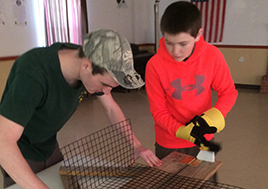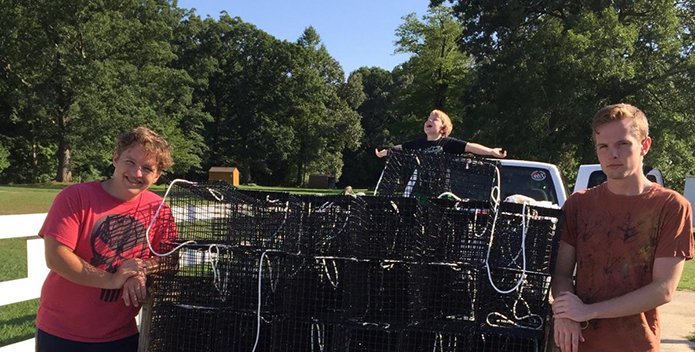The Chesapeake Bay's number one filter feeder is not one of the first things that come to mind for most Eagle Scout projects. However, for nine Scouts, that is exactly what they were thinking: oysters.
We have partnered with nine Scouts over the past two years to help them obtain their Eagle Scout Award and we have an additional three set to do their projects before the end of the year. Many have built shell bins for our shell recycling program or crafted cages for our oyster gardening program. In 2017 alone, the oyster gardening program used more than 500 cages, most of which were built during Eagle Scout projects.
With 320 families, businesses, or school groups caring for baby oysters for the 2017-2018 growing season, the oyster gardening program currently is booming. In fact, the program is so successful we ran into a minor crisis during the middle of our oyster gardening season because of the high number of cages being used for the events. We ran out! In a pinch, we needed about 150 cages built within two days. That's when one of our Scouts came to the rescue! Timothy Stull, a Carrollton Scout, offered to build more cages to help us in our time of panic. He and his family spent those two days building more cages for us, saving us from a room of disappointed oyster gardeners without any cages to work with. Talk about a Bay Saver!

Eagle Scout, Timothy Stull, assembles an oyster cage.
Heather North.
"My Eagle Project, in cooperation with the Chesapeake Bay Foundation, gave me an opportunity to learn more about oyster gardening and its impact on the Bay," says Stull. "Oysters play a very important role in filtering our Bay and making it a healthier environment. I was able to make oyster cages to support many families who raise oysters. I was proud to play a small part in helping this effort and encourage others in my troop to build cages. By supporting and helping our Bay, it will in turn support us."
During a typical Eagle project, the lead Scout is required to manage and organize the entire event. Cage building and shell bin constructing are two projects that require a lot of control and organization. Due to the range of ages in troops keeping everyone focused can be difficult, but not for these Scouts! Jack Suter, a Virginia Beach Scout, had an unusual situation during his project. Jack decided to build oyster gardening cages during our 50th Anniversary celebration, with more than 1,000 attendees visiting our Brock Environmental Center. Nevertheless, he was able to manage his troop, building more than 100 cages within two hours despite the steady stream of traffic.
During the Summer of 2016, Lea Bonner worked with us to receive her Girl Scout Gold Award. Lea launched a shell recycling program in her home city of Chesapeake, recruiting 10 restaurants, collecting thousands of oyster shells, building a public collection bin at her high school, and volunteering her time to help plant reef balls and baby oysters. Lea's dedication to clean water and the environment went beyond getting her award, she was truly trying to make a difference and set an example for the younger girls in her troop. Lea was chosen to receive one of the distinguished nationwide awards for her project, earning a college scholarship and recognition throughout the country. Way to go Lea!
We've been very lucky to have the Scouts assistance throughout the last two years, and we hope that we can continue working with them in the future. Each of these projects engages hundreds of Virginians in one of the many ways we can work together to Save the Bay.
A big thank you to all the Scouts who have worked with us on oyster restoration programs: Brendan Leary, Mac Simon, Lea Bonner, Bascombe Traywick, Noah Laythe, Scooter Haddad, Timothy Stull, Benjamin Smith, Joseph Smith, Jack Suter.




